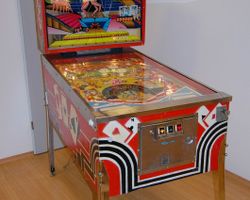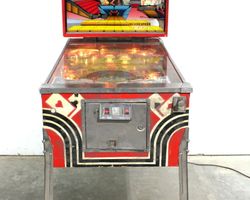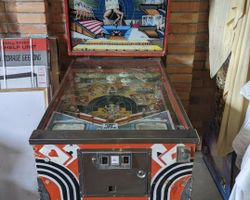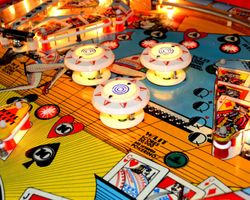Pokerino

Average Prices: USD $300 to $800
Produced: November, 1978
Production Run: 1,501 units
Machine Type: Solid State Electronic
MPU: Williams System 4
Players: 4
Design by: Steve Kordek
Art by: Constantino Mitchell
"Pokerino," a solid-state electronic (SS) pinball machine manufactured by Williams Electronic Games, Inc., emerged in October 1978, representing a distinctive entry in the company's lineup during the late 1970s. This widebody game, with its pronounced casino and card-playing theme, was conceived and largely designed by Steve Kordek, a prominent figure in pinball development. Kordek's influence extended beyond the initial concept, encompassing the machine's core mechanics, which aimed to challenge players with precision shooting. The vibrant, if polarizing, artwork was a collaboration between Constantino Mitchell and Jeanine Mitchell, who brought the machine's thematic elements to life with a kitsch 1970s style that incorporated stylized playing cards and showgirl imagery. Paul Dussault was responsible for the machine's sound design and software, contributing to the overall player experience with the distinct electronic tones characteristic of the era.
Released under the Williams System 4 generation of pinball machines, Pokerino entered the market with a production run of 1,501 units. Its manufacturing officially commenced on November 28, 1978, and concluded by April 24, 1979. Despite its relatively modest production numbers, Pokerino made a notable statement with its innovative features, particularly its widebody format and a unique flipper mechanism that set it apart from many of its contemporaries. This period was dynamic for pinball, with manufacturers experimenting with new technologies and gameplay concepts as solid-state electronics became standard. Pokerino's blend of established Williams design philosophy and new mechanical ideas positioned it as an intriguing, if sometimes divisive, offering in the competitive pinball landscape of the late 1970s.
Signature Features and Design
Pokerino distinguishes itself through several unique elements, most notably its "Double Action Flippers." This innovative mechanism allows players nuanced control: a partial press of the flipper button activates only the inner pair of the machine's four flippers, while a full press engages all four simultaneously. This dual functionality introduces a layer of strategy and skill not commonly found in other machines, requiring players to master the delicate balance between power and precision to execute specific shots.
Another defining characteristic is Pokerino's widebody cabinet. This larger playfield format directly influenced the machine's layout, providing ample space for its various interactive components and contributing to its open, expansive feel. Beyond the flippers and cabinet, Pokerino features a "King's captive ball" – a clever and unique playfield element. This captive ball is integrated into a specific area, requiring precise shots to manipulate it and score. The artwork, a vibrant expression of its card and casino theme, features bold yellow hues on the playfield, complemented by illustrations of poker hands and showgirls on both the playfield and backglass. While capturing a distinct 1970s aesthetic, this artistic choice has historically generated mixed reactions within the pinball community.
Playfield and Mechanics
The Pokerino playfield, spacious due to its widebody design, is an open layout that emphasizes shot accuracy over complex ramps or multi-level arrangements. At its core, the playfield features four flippers, central to utilizing the machine's distinctive double-action mechanism. Three pop bumpers provide chaotic ball movement and scoring opportunities, positioned strategically to create action in the upper playfield. Two slingshots further contribute to unpredictable ball trajectories, keeping players vigilant.
The layout incorporates eight star rollovers, which typically illuminate progress towards bonus multipliers or special features when activated. A key feature for scoring and progression is the array of drop targets: a prominent 4-bank set, two smaller 2-bank sets, and a single isolated drop target. Successfully clearing these banks often advances game objectives, such as completing poker hands. Four captive balls are present, with one specifically designated as the "King's captive ball," which can be a focal point for high-scoring strategies. A single spinning target adds another dynamic element, rewarding precise shots with accumulated points.
Steve Kordek's design philosophy, evident in Pokerino, favored clear lines of sight and an emphasis on shooting lanes, encouraging players to develop precise aiming skills. The open nature of the playfield allows for a high degree of ball speed and flow, challenging players to react quickly and maintain control. The artwork, while embodying a distinct 1970s style with its bold yellow background and card-themed motifs, is often critiqued for its perceived crudeness and susceptibility to wear over time, particularly the flaking of the backglass and playfield art. Despite this, the aesthetic contributes to the machine's unique identity and instantly places it within its historical context.
Gameplay Dynamics
Pokerino's gameplay mechanics revolve around a relatively simple ruleset, making it accessible for new players while offering depth for those seeking mastery. The primary objective often involves completing specific poker hands by hitting the various drop targets and activating rollovers. Each bank of drop targets, whether the 4-bank, 2-bank, or single target, contributes to this progression, with rewards escalating as more complex hands are completed. The eight star rollovers further enhance scoring and can build up bonus multipliers.
The double-action flippers are central to gameplay strategy. Players must learn to skillfully manipulate these flippers, using the inner pair for precise, short shots and the full four-flipper activation for powerful, longer shots or recovery. This nuanced control is crucial for targeting specific drop targets, navigating around the pop bumpers, and hitting the spinning target for accumulated points. The King's captive ball presents a unique challenge, requiring repeated, accurate hits to score significantly or trigger special features. Skill shots are achievable from the plunger, rewarding players who can accurately launch the ball into designated areas of the playfield. The game's flow, characterized by an open playfield, encourages continuous ball movement and necessitates quick reflexes. Players aiming for high scores will often focus on clearing drop target banks efficiently while strategically utilizing the double-action flippers to control the ball's trajectory and maximize scoring opportunities from the various playfield elements.
Reception and Legacy
The reception of Pokerino within the pinball community is notably mixed, reflecting a broad spectrum of opinions from its initial release to contemporary appraisal. On one hand, players acknowledge its challenging nature and the satisfaction derived from mastering its unique mechanics. Enthusiasts often highlight the precision required for its shots, appreciating the open playfield that rewards accurate shooting skills. The "King's captive ball" is frequently cited as an ingenious and distinctive feature, adding a unique twist to gameplay. Furthermore, the double-action flippers, while initially daunting, offer a depth of control that some find rewarding to conquer. The simple, understandable ruleset also makes it approachable for new players, providing an immediate entry point into its gameplay. For collectors who have meticulously restored these machines, the experience of playing a near-perfect Pokerino is often described as gratifying.
Conversely, Pokerino faces significant criticism, primarily regarding its aesthetics. The artwork, particularly the playfield's prominent yellow background, is often described as crude or unattractive, an acquired taste that many struggle to embrace. The propensity for the backglass and playfield art to flake or wear significantly over time further compounds these visual concerns. From a gameplay perspective, the double-action flippers, while innovative, are often cited as difficult to master, leading to frustration for some players. Critics also point to areas of "wasted space" on the widebody playfield, suggesting that the expansive design doesn't always translate into a richer gameplay experience. For some, the game can feel repetitive or lacking in excitement, contributing to an opinion that it stands as one of Williams' weaker offerings from the late 1970s.
Despite the polarized views, Pokerino maintains a distinct place in pinball history. Its limited production run of 1,501 units contributes to its rarity, making it a noteworthy find for collectors. As part of the Williams System 4 generation, it represents an experimental period for Williams, showcasing the company's willingness to implement novel mechanical features like the double-action flippers and to explore the widebody format. While its influence on future machine designs might not be as widespread as other titles, Pokerino serves as a historical marker for a specific design philosophy and a unique approach to player interaction, ensuring its continued discussion among pinball enthusiasts.
Sponsored Links
 Ebay Listings
Ebay Listings
 Auction Results
Auction Results
| Cost | Location | Date |
|---|---|---|
| USD $425 |  Maryland, United States Maryland, United States |
26 June, 2025 |
| USD $750 |  Pennsylvania, United States Pennsylvania, United States |
19 August, 2024 |
| GBP £550 |  Preston, United Kingdom Preston, United Kingdom |
12 April, 2024 |
| USD $500 |  Minnesota, United States Minnesota, United States |
26 July, 2023 |
| USD $900 |  Maryland, United States Maryland, United States |
23 February, 2023 |
| AUD $1,400 |  Victoria, Australia Victoria, Australia |
16 April, 2022 |
| USD $870 |  Colorado, United States Colorado, United States |
25 November, 2021 |
| GBP £525 |  United Kingdom United Kingdom |
19 January, 2021 |
| GBP £468 |  United Kingdom United Kingdom |
14 December, 2020 |
| USD $471 |  California, United States California, United States |
14 September, 2020 |


Private Policy · Search Website · Contact Us
As an eBay Partner, we may earn a commission from qualifying purchases made through links on this site, at no additional cost to you.
All trademarks and copyrighted materials remain property of their respective owners. All other content copyright 2007 - 2025 Pinpedia.







